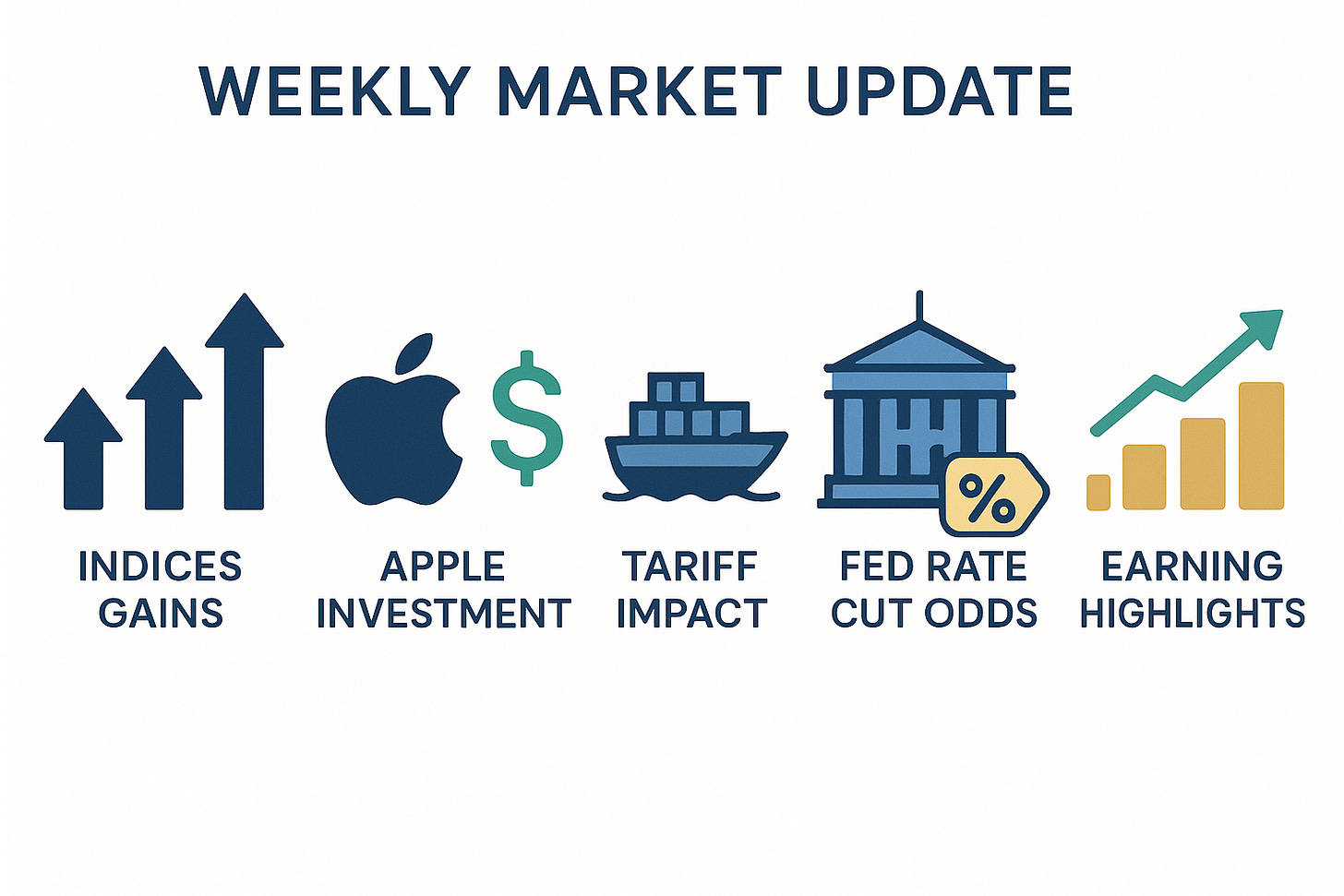📊 Weekly Market Update
Trump Tariffs and Tech Rally Drive Record Highs
The stock market bounced back brilliantly this week as investors shrugged off concerns about tariffs, weak economic data, and inflation fears. The Nasdaq hit fresh record highs while the S&P 500 climbed back near all-time levels, driven by a powerful combination of Fed rate cut expectations and stellar corporate earnings. Despite some choppy sessions, major indices posted solid weekly gains with technology leading the charge once again.
📈 What's Happening
Markets staged an impressive recovery from last week's selloff, with the Nasdaq surging 3.9%, the S&P 500 gaining 2.4%, and the Dow rising 1.3% for the week.
Apple stole the spotlight with its biggest weekly gain in months, jumping 13.3% after announcing an additional $100 billion investment in U.S. manufacturing to avoid Trump's semiconductor tariffs. The tech giant's commitment to build more iPhone components domestically helped it secure an exemption from the planned 100% tariffs on imported chips.
Trump's tariff strategy dominated headlines as the president imposed 100% tariffs on semiconductor imports while offering exemptions to companies manufacturing in the U.S.. Major chipmakers like TSMC, Samsung, and SK Hynix quickly highlighted their domestic investments to secure exemptions.
Fed rate cut expectations skyrocketed to 94.9% probability for September after disappointing jobs data showed only 73,000 jobs added in July, well below the 110,000 estimate. Multiple Fed officials turned dovish, with some suggesting rate cuts are necessary to support the slowing labor market.
Gold prices exploded to new record highs above $3,534 per ounce after reports suggested gold bars would be subject to Trump's tariffs, creating panic in bullion markets. The precious metal gained nearly 40% year-to-date.
Corporate earnings delivered mixed results with standout performances from Palantir (48% revenue growth) and Microsoft (18% revenue growth), while Eli Lilly disappointed with weight-loss drug trial results.
⚡ Why It Matters
This market resilience reveals several critical dynamics shaping investor sentiment heading into the crucial August-September period.
The Trump administration's "carrot and stick" tariff approach is creating clear winners and losers. Companies investing domestically are being rewarded with exemptions, while those remaining overseas face punitive duties. This reshoring incentive is driving massive capital commitments from tech giants and could fundamentally reshape global supply chains.
Federal Reserve policy is at an inflection point. With two dissenting votes in July calling for rate cuts and mounting economic weakness, the central bank appears poised to pivot. However, tariff-driven inflation risks create a potential policy dilemma - cutting rates to support growth while tariffs push prices higher could spark stagflation fears.
The AI trade remains incredibly concentrated. Just five stocks accounted for most of the market's valuation increases, with companies like Nvidia and Microsoft driving outsized returns. This concentration creates both opportunity and risk as any disappointment from AI leaders could trigger broader market corrections.
Seasonal headwinds are approaching. August historically sees increased volatility, and with elevated valuations (S&P 500 trading at 22x forward earnings vs. 15.8x historical average), markets are vulnerable to pullbacks.
💰 Opportunities
Technology stocks offer compelling plays for investors willing to embrace volatility. Microsoft's strong cloud growth and AI monetization make it attractive near current levels, while Apple's domestic manufacturing strategy could provide tariff protection. Palantir continues its explosive growth but demands caution given extreme valuations.
Gold and precious metals present a hedge against tariff-induced inflation and currency debasement. With central banks buying aggressively and industrial demand robust, silver could outperform with targets of $40 per ounce.
Defensive sectors like healthcare and consumer staples may offer refuge during the typically volatile summer months. With growth slowing and inflation risks persisting, companies with pricing power and stable cash flows become more attractive.
Rate-sensitive assets including REITs and utilities could benefit from Fed policy normalization, though timing remains crucial given mixed economic signals.
🎯 Bottom Line
This week's rally masked underlying tensions that could define markets through year-end. While corporate earnings remain solid and Fed easing appears likely, the combination of elevated tariffs, slowing growth, and stretched valuations creates a challenging backdrop.
The key catalyst ahead is Tuesday's Consumer Price Index report, which could determine whether the Fed cuts aggressively or pauses given inflation concerns. Any surprise could trigger significant volatility in an already stretched market.
Smart investors should prepare for increased choppiness while maintaining exposure to quality names that can navigate the evolving tariff landscape. The companies positioning themselves for the "America First" economy - like Apple, Microsoft, and domestic manufacturers - appear best positioned for the challenges ahead.
August and September historically test market resilience, and this year's unique combination of policy uncertainty and extreme valuations suggests the coming weeks will be critical for determining whether this bull market can continue its remarkable run.
Sign up now and get our free REITs’ Numerical Ratings.
Disclaimer: This article constitutes the author’s personal views and is for entertainment and educational purposes only. It is not to be construed as financial advice in any form. Please do your own research and seek advice from a qualified financial advisor. From time to time, I have positions in all or some of the mentioned stocks when publishing this article. This is a disclosure - not a recommendation to buy or sell stocks.

